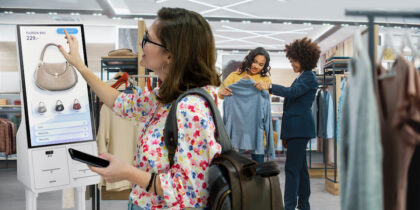As consumer connectivity becomes more pervasive and complex, innovative retailers have a great opportunity to widen their lead on their less tech-savvy competitors.
Whatever you sell, your customers are embracing ubiquitous networking. They are surrounding themselves with smart assistants, wearable technology and connected devices like the Samsung Family Hub refrigerator that enable them to use the internet without handling a dedicated computing device. There is uncertainty about which technologies will prevail, but there is no doubt that communication modes will continue to evolve year over year, particularly as 5G networking emerges.
Amidst so much change, it is beneficial to embrace first principles thinking, recently popularized by Elon Musk. This involves analyzing our challenges and opportunities with a clean slate, free from pre-existing ideas. If you were building a retail operation from the ground up today, how would you structure the customer experience? You might take some of the following approaches.
Outfit Store Associates With Smart Devices
The customer experience no longer begins in the store. Before your floor associate speaks with a customer, that person has likely already been on your website and may have purchase history that you’re capturing in a database and surfacing for your digital marketing team. But customer data can’t live in these silos forever. There’s an enormous amount of power in providing store associates with useful data about the customer’s historical (and even same-day) interactions with your brand.
Consider creating a 1:1 program for your stores where every associate gets a mobile device. Suddenly, every associate has rich data and powerful search capabilities in the palm of their hand, and a brand new hire can deliver answers with confidence as though they had worked in the store for years. Moreover, employees of all experience levels will have more targeted information to better lead the customer down the path to purchase without forcing them back to the beginning of their journey.
Reform the Checkout Process
The typical brick-and-mortar checkout experience was designed around cash transactions and did not really evolve when credit and debit cards became common. If you were building a retail experience from the ground up today, you wouldn’t design the entire process around a cash drawer and a queue.
Transform Retail Associate Performance
Get your free guide to empowering retail associates with mobile devices and data. Download Now
A 1:1 device program gives you the opportunity to minimize the number of cash lanes needed while empowering floor associates not only to serve customers, but to take payments. This saves you money on cash lane scanners and computers while also giving the customer a more personalized experience, as the associate who helps them is also likely to complete their transaction.
Leverage the “Universal Platform”
In-home connected devices are already beginning to challenge your powers of strategic thinking, and the advantage goes to businesses that ask questions like: How can we predict and prepare items for delivery or pickup before the customer even recognizes they need them? How can we leverage what we know about the customer’s day to make better product recommendations in our marketing emails?
The promise of IoT is yet to be fully realized, but thinking about how your marketing and sales strategy will take it into account as it evolves will ready your business for the years ahead.
Connect With the Connected Consumer
It’s time to revisit your customer journey map and make the widescale changes that will keep you relevant. The best advice I can offer is to embrace innovation. Accept that technology is disrupting your business and commit to moving towards new opportunities. One great way to start is to make Android your core computing platform. When you commit to Android, you trade the oversized, fixed devices that hold you back for lightweight smartphones and tablets that pack as much computing power as most laptops. With Windows CE sunsetting and Android being the leading replacement, a prudent move would be to keep your devices in sync. Unlike any other Android solution, Samsung offers defense level security, so the data you are analyzing not only provide opportunities for strong ROI but are also kept out of the wrong hands. You also protect yourself from crippling security breaches. Samsung also provides remote device management that helps retailers keep their devices up to date with the latest OS updates and application versions and block the use of unauthorized apps.
Mobility is the path forward in industries as varied as healthcare, transportation and public safety, and retail is no exception. At Samsung, we know retail, and we excel at innovation. In fact, we hold more U.S. patents than any other company. Please stop by Booth 2337 at NRF and find out how our technology and innovative strategies can transform your stores and create experiences that keep customers coming back for more.
Samsung retail solutions are reimagining how associates and consumers connect across channels. Get a look at some of the innovations leading the charge.








